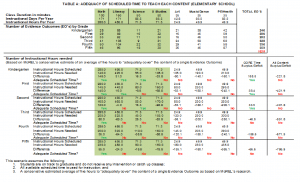Is There Enough Time for Learning?
CompetencyWorks Blog

Because of the growing number of mass-administered, required tests under state and/or federal law, there is an increasing and unsustainable demand being placed on student time in school. In recent years, these mandated test increases have affected students in Colorado at all grade levels, from kindergarten through twelfth grade.
While student assessment is vital to learning, excessive testing is not, particularly in the way it is handled today. The quantity and quality of instructional time is what matters most for productive learning to occur.
Our experience in Adams County School District 50 has shown that a mass administration of the same test to students of the same age at the same time does not promote learning. In fact, it penalizes students, their teachers, and their schools. An overemphasis on testing significantly reduces the quantity and quality of time that could be better utilized in closing the achievement gap: something our data shows we are successfully doing.
The Teaching Learning Cycle in a Competency-Based System
We all know that teaching and learning take place in the classroom. As educators, we refer to this cyclic process as the Teaching Learning Cycle.

For learning to occur in a meaningful way, there must be balance and alignment between each component of the cycle (namely: standards, instruction, and assessment). If the cycle becomes imbalanced in any one of these areas, teaching and learning are significantly impacted. Achievement stagnates or, worse, regresses. There must be adequate time to implement each component on the cycle in a dynamic, reciprocal manner.
While we have made consistent academic improvement in our school district as a result of implementing a Competency Based System, we have encountered three major interrelated challenges – challenges we are actively seeking technical assistance from the state to help resolve. They are:
- Ensuring a guaranteed viable curriculum
- Creating flexibility to administer high stakes assessments
- Establishing a competency-based approach to accountability
In a Competency Based System, the standards, instruction, and assessment (Teaching Learning Cycle) interact differently and even more dynamically to support a learner-centered classroom. For example, within this system, we might focus more on the continuous and routine formation of small instructional groups based upon each student’s learning progression.
The Impact of Time on Testing and Learning
Educators across the nation decry the immediate imbalance and impact of additional mass-administered tests, which cut back on instructional time and narrow the curriculum. Educators, especially those whose effectiveness is determined by student scores, are being forced to spend more time covering the content areas that are annually assessed to the detriment of other areas.
However, a much bigger issue, in my opinion, is the number of Evidence Outcomes students are expected to know and be able to do in all content areas in the amount of time available. The accompanying article Is Competency Based Education Feasible Without a Guaranteed Viable Curriculum? examines the impact the number of Evidence Outcomes has on a system by analyzing the amount of time available in a school schedule to determine if it is adequate.
Table A in the Appendix at the end of this document shows an example of a typical elementary school schedule and compares the amount of time available with the number of Evidence Outcomes that need to be learned. The table shows each content area taught along the top row, with the core content areas of Math, Literacy (Reading and Writing), Science, and Social Studies highlighted in green. On the left side of the table, we see the amount of time available as well as the number of Evidence Outcomes by grade level. The lower portion of the table shows the calculation to determine if there is adequate scheduled time to “cover” the number of prescribed Evidence Outcomes.
The first notable fact we see is the variance in the number of minutes per instructional area. Math is scheduled for 100 minutes per day, creating 285 instructional hours per year. Literacy is scheduled for even more, while Science and Social Studies are scheduled for 50 minutes every other day. The “specials” are scheduled for the least amount of time. When the amount of time available is compared with number of Evidence Outcomes in which teachers are expected to bring all students to proficiency, we see disproportionate allotments depending on the content area. Clearly, those allotments are skewed in favor of those subjects that are most heavily tested.
Critics will argue that you can combine or integrate different content areas and save instructional time, but I have not found any empirical research to support the theory. To help minimize this conflict in Adams County School District 50, we have tried to prioritize our standards according to how frequently they were assessed; however, we have discovered that there are still far too many Evidence Outcomes to adequately cover in the time available. This is especially true if a student enters school already behind and/or has significant learning gaps. For these students and teachers, it then becomes a race to cover or at least expose learners to as many Evidence Outcomes as possible before the mass-administered test.
Predictably, when this type of “exposure teaching” occurs, students will not have the depth of knowledge needed to apply their surface understandings of learning in a meaningful way even on the test. We have the data to prove that exposure teaching has never worked and is completely counterproductive in a competency-based system.
It is not just elementary school students experiencing these challenges. Table B in the Appendix shows an example of a typical middle school schedule. By looking at this example, it becomes immediately apparent that each content area is scheduled for the same amount of time – but in almost every instance, the amount of scheduled time is inadequate.
Moving Forward
Our takeaway here is that the problem of insufficient learning time comes not just from excessive mass-administered testing at arbitrary points in time, but also from the sheer number of Evidence Outcomes that must be taught and learned within the time available.
In our Competency Based System at Adams Count School District 50, we expect students or more appropriately our to become competent in all content areas – not just those that are assessed annually. With that as a goal, we must adopt a common sense approach to support the dynamic, reciprocal interaction of standards, instruction, and assessment that can restore balance to the components of the Teaching Learning Cycle at the classroom level.
– – –
APPENDIX
TABLE A: Adequacy of scheduled time to teach each content area (Elementary School)

TABLE B: Adequacy of scheduled time to teach each content area (Middle School)

Oliver Grenham is Chief Education Officer at Adams County School District 51